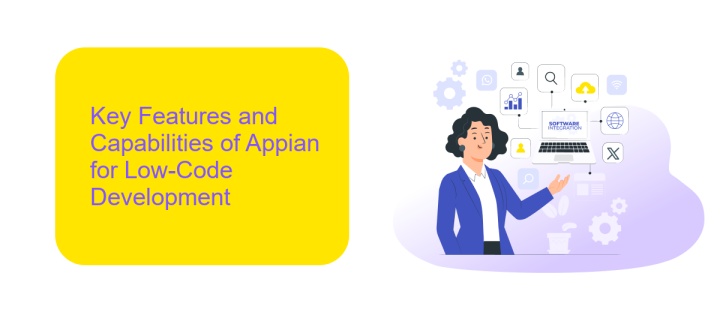Low-Code Application Development With Appian
In today's fast-paced digital landscape, businesses are seeking efficient ways to develop applications without the extensive coding traditionally required. Low-code platforms like Appian are revolutionizing this process by enabling rapid application development with minimal hand-coding. This approach empowers organizations to streamline workflows, enhance productivity, and quickly adapt to market changes, all while reducing the demand for specialized programming skills.
Introduction to Low-Code and Appian
Low-code development is revolutionizing how businesses approach software creation by minimizing the need for extensive coding knowledge. This approach allows users to design applications through graphical interfaces and pre-built modules, significantly reducing development time and costs. Appian, a leading low-code platform, empowers organizations to streamline their processes and enhance productivity by enabling rapid application development.
- Accelerated development cycles: Low-code platforms like Appian enable faster deployment of applications.
- Enhanced collaboration: Teams can work together more effectively with visual development tools.
- Cost efficiency: Reducing the need for specialized coding skills can lower development expenses.
- Flexibility and scalability: Applications can be easily modified and scaled to meet evolving business needs.
Appian stands out in the low-code landscape by offering robust features such as process automation, data integration, and user-friendly interfaces. Its platform is designed to cater to both IT professionals and business users, fostering an environment where innovative solutions can be quickly developed and deployed. By leveraging Appian, companies can stay competitive in a fast-paced digital world, ensuring they meet their strategic goals effectively.
Key Features and Capabilities of Appian for Low-Code Development

Appian empowers low-code development with a suite of intuitive features designed to streamline application creation. Its drag-and-drop interface simplifies complex processes, enabling users to build applications swiftly without extensive coding knowledge. Appian's robust process automation capabilities allow for the seamless design of workflows, enhancing operational efficiency. The platform's visual tools facilitate easy customization, ensuring applications meet specific business needs while maintaining flexibility for future adjustments.
Integration is a key strength of Appian, with built-in connectors that enable quick and efficient integration with various systems. For more advanced integration needs, services like ApiX-Drive can be utilized to automate and connect disparate applications, further enhancing Appian's capabilities. Additionally, Appian offers powerful data management features, providing users with real-time insights and analytics to drive informed decision-making. Its security features ensure that applications are protected against potential threats, offering peace of mind for businesses operating in sensitive environments.
Building Applications with Appian: A Practical Overview

Appian provides a robust platform for building low-code applications, streamlining the development process with its intuitive interface. Users can rapidly design applications by leveraging Appian's drag-and-drop functionality, which minimizes the need for extensive coding knowledge. This approach not only accelerates deployment but also ensures that applications are scalable and adaptable to changing business needs.
- Begin by defining your application's requirements and objectives.
- Utilize Appian's process modeler to map out workflows visually.
- Incorporate data by connecting to existing databases or using Appian's data management tools.
- Design user interfaces with Appian's interface designer, ensuring a user-friendly experience.
- Test the application thoroughly to identify and rectify any issues.
- Deploy the application and monitor its performance using Appian's analytics.
By following these steps, organizations can efficiently create applications that meet specific business requirements. Appian's low-code platform empowers users to innovate without the constraints of traditional development, enabling faster go-to-market strategies and fostering a culture of continuous improvement. Whether you're developing simple workflows or complex enterprise solutions, Appian offers the tools needed to succeed.
Benefits and Drawbacks of Using Appian for Low-Code Development

Appian is a prominent platform in the low-code development landscape, offering a streamlined approach to application creation. It enables developers to build complex applications with minimal coding, significantly reducing development time and costs. The platform's intuitive drag-and-drop interface allows users to create workflows and automate processes efficiently. Additionally, Appian integrates seamlessly with various systems, enhancing its versatility and scalability.
Despite its benefits, Appian is not without its drawbacks. The platform's licensing can be costly for small businesses, potentially limiting accessibility for startups. Furthermore, while Appian simplifies development, it may also impose limitations on customization, which could be a concern for businesses with highly specific needs.
- Rapid application development and deployment
- Intuitive user interface for ease of use
- Seamless integration with existing systems
- Potentially high licensing costs
- Limitations on deep customization
In conclusion, Appian provides a robust solution for enterprises seeking to expedite their development processes. While it offers significant advantages in terms of speed and integration, businesses must weigh these benefits against the costs and potential constraints on customization. Ultimately, the decision to use Appian should align with the organization's specific requirements and resources.
Real-World Use Cases and Success Stories of Appian Implementations
Appian has been instrumental in transforming business operations across various industries by enabling rapid application development. One notable use case is in the healthcare sector, where Appian has streamlined patient management systems, improving both efficiency and patient care. Hospitals have leveraged Appian's low-code platform to develop applications that automate scheduling, patient data management, and billing processes, resulting in significant time and cost savings.
In the financial services industry, Appian has empowered organizations to enhance their compliance and risk management systems. By integrating with services like ApiX-Drive, financial institutions can seamlessly connect Appian with other software solutions, ensuring real-time data synchronization and improved decision-making. This integration capability has led to more agile responses to regulatory changes and improved customer service. These success stories highlight Appian's ability to adapt to diverse business needs, delivering tangible results and fostering innovation.
FAQ
What is Low-Code Application Development with Appian?
How does Appian ensure data security and compliance?
Can Appian applications integrate with existing systems?
Who can benefit from using Appian's low-code platform?
What types of applications can be built with Appian?
Apix-Drive will help optimize business processes, save you from a lot of routine tasks and unnecessary costs for automation, attracting additional specialists. Try setting up a free test connection with ApiX-Drive and see for yourself. Now you have to think about where to invest the freed time and money!

